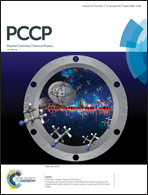Incorporation of aspirin modulates the dynamical and phase behavior of the phospholipid membrane†
Abstract
Nonsteroidal anti-inflammatory drugs (NSAIDs) are one of the most widely used medications in the world for their analgesic, antipyretic, and anti-inflammatory actions, despite a well-known incidence of a wide spectrum of their adverse effects. To a great extent, beneficial action and side effects of NSAIDs are associated with the interaction of these drugs at the cell membrane level. Here, we use neutron scattering to combine elastic intensity scans, quasielastic and neutron spin echo (NSE) measurements to understand the effect of aspirin, a commonly used NSAID, on the dynamical and phase behavior of the membrane of dimyristoylphosphatidylcholine (DMPC), a prominent representative of phospholipids residing in the outer leaflet of the human erythrocyte membrane. Elastic intensity scans reveal that addition of aspirin not only eliminates the pre-transition (solid gel to ripple phase), but also broadens the main phase transition (ripple to fluid phase) in the membrane. Moreover, the main phase transition becomes shifted toward a lower temperature. These results are found to be consistent with our differential scanning calorimetry measurements. Elastic intensity scans further suggest that aspirin inhibits the membrane from going into the ordered phase and overall induces disorder in the membrane, thus indicating enhancement in the fluidity of the membrane. Quasielastic neutron scattering (QENS) data show that aspirin affects both lateral lipid motion within the leaflet and the localized internal motion of the lipid. Aspirin accelerates both lateral and internal motions, with the more pronounced effect observed for the ordered phase of the neat membrane. Intermediate scattering function as observed by NSE has been analyzed using the Zilman Granek model, which indicates that addition of aspirin alters the bending modulus of the membrane to make the membrane softer. Our study provides a quantitative description of the effect of an archetypal NSAID, aspirin, on the various physical properties of the model biological membrane, which is essential for understanding the complex drug–membrane interaction.



 Please wait while we load your content...
Please wait while we load your content...